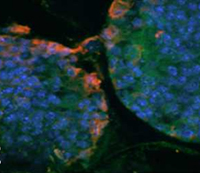Jan 4 2009
Artificial bone marrow that can continuously make red and white blood cells has been created in a University of Michigan lab.

This development could lead to simpler pharmaceutical drug testing, closer study of immune system defects and a continuous supply of blood for transfusions.
The substance grows on a 3-D scaffold that mimics the tissues supporting bone marrow in the body, said Nicholas Kotov, a professor in the U-M departments of Chemical Engineering; Materials Science and Engineering; and Biomedical Engineering.
The marrow is not made to be implanted in the body, like most 3-D biomedical scaffolds. It is designed to function in a test tube.
Kotov, principal investigator, is an author of a paper about the research currently published online in the journal Biomaterials. Joan Nichols, professor from the University of Texas Medical Branch, collaborated on many aspects of the project.
"This is the first successful artificial bone marrow," Kotov said. "It has two of the essential functions of bone marrow. It can replicate blood stem cells and produce B cells. The latter are the key immune cells producing antibodies that are important to fighting many diseases."
Blood stem cells give rise to blood as well as several other types of cells. B cells, a type of white blood cell, battle colds, bacterial infections, and other foreign or abnormal cells including some cancers.
Cancer-fighting chemotherapy drugs can strongly suppress bone marrow function, leaving the body more susceptible to infection. The new artificial marrow could allow researchers to test how a new drug at certain potencies would affect bone marrow function, Kotov said. This could assist in drug development and catch severe side effects before human drug trials.
Bone marrow is a complicated organ to replicate, Kotov said. Vital to the success of this new development is the three-dimensional scaffold on which the artificial marrow grows. This lattice had to have a high number of precisely-sized pores to stimulate cellular interaction.
The scaffolds are made out of a transparent polymer that nutrients can easily pass through. To create the scaffolds, scientists molded the polymer with tiny spheres ordered like billiard balls. Then, they dissolved the spheres to leave the perfect geometry of pores in the scaffold.
The scaffolds were then seeded with bone marrow stromal cells and osteoblasts, another type of bone marrow cell.
"The geometrical perfection of the polymer molded by spheres is very essential for reproducibility of the drug tests and evaluation of potential drug candidates," Kotov said. "The scaffold for this work had to be designed from scratch closely mimicking real bone marrow because there are no suitable commercially products.
"Certain stem cells that are essential for immunity and blood production are able to grow, divide and differentiate efficiently in these scaffolds due to the close similarity of the pores in the scaffold and the pores in actual bone marrow."
The researchers demonstrated that the artificial marrow gives a human-like response to an infectious New Caledonia/99/H1N1 flu virus. This is believed to be a first.
To determine whether the substance behaves like real bone marrow, the scientists implanted it in mice with immune deficiencies. The mice produced human immune cells and blood vessels grew through the substance.
The paper is called "In vitro analog of human bone marrow from 3D scaffolds with Biomimetic inverted colloidal crystal geometry."